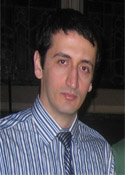
On February 7th, 2013, Professor Brian Pogue, research scientist Scott Davis, and former Optics in Medicine post doc Hamid Dehghani are teaching an introductory workshop on Near-Infrared Fluorescence and Spectral Tomography (NIRFAST) at the Society of Photo-Optical Instrumentation Engineers (SPIE) Photonics West conference in San Francisco. Developed by the Optics in Medicine Laboratory, Nirfast is used in hospitals and research institutions across the US to model Near-Infrared light transport in tissue. Nirfast is an open source software package that can be downloaded for free, and customized to work with a laboratory’s imaging equipment.
For the duration of his post doctoral position in Dartmouth’s Optics in Medicine Laboratory, research fellow Hamid Ghadyani has improved Nirfast’s meshing capabilities, and added a number of much needed functions to the software package. Hamid received his Bachelors of Science in Mechanical Engineering from Sharif University of Technology in Tehran, Iran, started his masters degree at Temple University, PA, and completed both his masters and doctoral degrees in Mechanical Engineering at Worcester Polytechnic Institute (WPI). In 2010, Hamid presented the Boundary Element Method (BEM) computational work he was doing on Nirfast at the SPIE Optics + Photonics conference in San Diego, and later published the research as “Characterizing accuracy of total hemoglobin recovery using contrast-detail analysis in 3D image-guided near infrared spectroscopy with the boundary element method” in Optics express, 07/2010; 18(15): 15917-35.

While the Finite Element Method (FEM) approximates a partial differential equation (PDE) over many smaller regions of the entire domain, BEM solves partial differential equations that Green’s function—a function used to solve differential equations with boundary conditions—can be calculated for. In conjunction with Green’s function, boundary conditions are used to solve PDE on the boundary of the domain. The integration of this computational method into Nirfast enables the software bundle to quickly solve a light transport equation without a full-blown step of solid mesh generation.
“The real advantage of BEM is that it simplifies the meshing step. In FEM, mesh creation can account for up to 75 percent of a model’s computational efforts,” explains Hamid. “At the SPIE Optics + Photonics 2010 conference in San Diego, I explained how the Optics in Medicine Laboratory was using BEM-based imaging to model smaller cancer tumors that, in some situations, FEM meshing was unable to detect.”
Through a collaboration with the University of Texas at Austin (UT Austin), Hamid used Dartmouth’s Discovery cluster—a 1704 processor RedHat 5.8 super computer with AMD, Intel, and Nvidia CPUs—to research how small of a tumor Nirfast was able to image. With a software package developed at UT Austin, Hamid ran a simulation on the Discovery cluster that used an impressive 127 GB of Random-access memory (RAM). This research was presented at last year’s Optics Society of America’s (OSA) Miami conference.

“My main research interest is developing computational tools that help researchers in biomedical fields harness the power of the FEM method. This involves developing mesh generation algorithms, and high-performance parallel numerical methods,” explains Hamid. “FEM is based on the idea of simplifying PDEs over much smaller sub-regions. The creation of these sub-regions is an important step in any Finite Element analysis as it can affect the accuracy and reliability of solutions. I have streamlined and added advanced features to mesh generation capabilities of Nirfast so that users with almost no background can use meshing tools in their research. This cuts down both the computational time of mesh generation, and the time spent preparing the model significantly.”
Ghadyani has conducted his mesh generation study with current graduate students Kelly Michalsen and Michael Mastanduno, as well as former lab members Amir Golnabi and Xiahxayo Fan. The tools developed by Ghadyani and his collaborators is used by engineers, as well as other professionals who utilize mesh-generation in imaging on a regular basis, including those involved with Electro-Imdepdence tomography, Magnetic Resonance Elastography, and Microwave Imaging Spectroscopy.